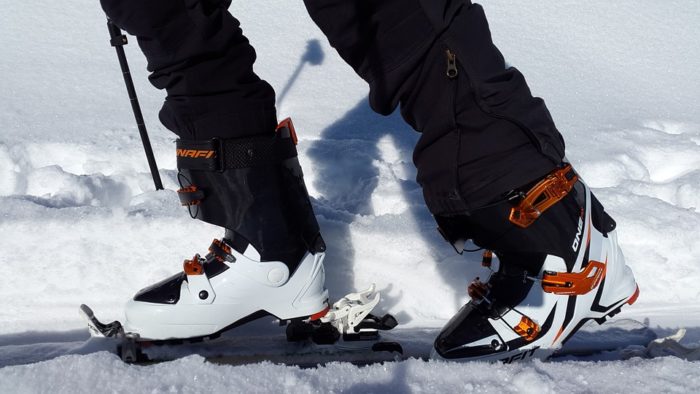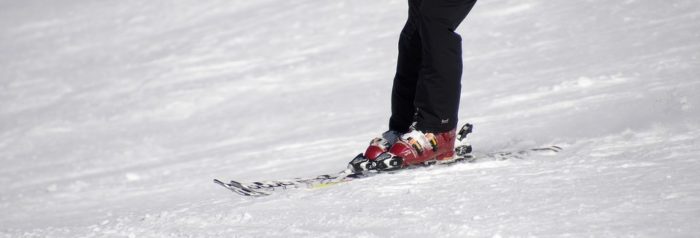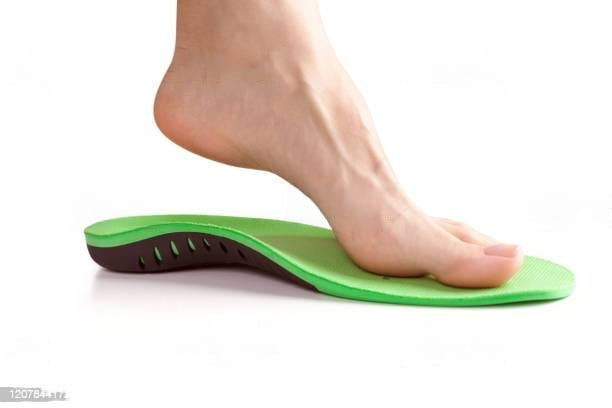It is imperative that you choose the right ski boot insoles to support your feet for maximum comfort.
Although ski boots provide the necessary support for most skiers, it may not be the case for skiers with flat feet or those who need extra arch support.
That’s where to ski boot insoles come into play.
Good insoles will not only help protect your feet from the cold but can also give you more stability while skiing.
They minimize your risk of injuries since they improve your overall comfort in the snow.
But, how do you choose the right ski boot insoles for flat feet and arch support?
Read the below article to know more about some of the best ski boot insoles available this 2023.
Best Ski Boot Insoles

Superfeet REDhot Insoles
The Superfeet REDhot Insoles provide superior comfort and edge control, giving you a fantastic balance of warmth and performance when it starts snowing.
It features a Superfeet Shape that helps stabilize and support your arch, allowing you to walk more efficiently and keep your ankles, feet, and knees comfortable.
They’re designed to support and provide cushioning for anyone with flat feet or who needs arch support.
This full-length insole will help you run and ski for a longer duration.
From the slopes to the sidewalks, its closed-cell foam provides all-day support and cushioning.
However, some people have mentioned that the foam is a little too soft.
Apart from this, these insoles are designed with a deep, narrow heel cup; this helps absorb shock and position the foot correctly to protect you from snow as well as give you the balance and stabilization that you need.
Furthermore, starring a unique and durable thermal construction that preserves the original shape, these insoles deliver reliable support and comfort for up to 12 months/500 miles, whichever comes first.
It also features a top cover treated with patented Outlast Adaptive Comfort to absorb, store and release warmth.
You will also find a light but durable insulating foil that deflects cold away from the forefoot, keeping feet warm at the outset of your day and as you progress on the mountain.
Easyfeet Strong Arch Support Insoles
The Easyfeet Strong Arch Support Insoles are targeted at people who have plantar fasciitis, flat feet, overpronation, and other similar conditions.
So if you’re one of them, these premium podiatrist-recommended sole shoe inserts are a life-saver.
With a good level of arch support and shock-absorbing effect, these inserts can alleviate the pain caused by flat feet.
In addition, these can make a pleasant difference in pressure distribution around the foot for skiers with flat feet or faulty alignment.
Additionally, it has a deep heel that gently cradles your heel to provide support from knees to feet.
It also has built-in heel support that keeps the foot bone vertical to provide stability and promote balance.
These insoles are made of a TPU and cushioning layer with a PU memory foam base, providing both support and shock absorption for the foot.
Also, the heat and friction-reducing velvety breathable cover provides additional comfort while you are on the go.
The Easyfeet Plantar Fasciitis Arch Support Insoles are available in various sizes for both men and women and can further be easily trimmed and adapted to fit your ski boots.
However, some users have pointed out that these inserts can be difficult to put on and remove inside the boots.
Sole Softec Response Custom Footbed
The Sole Softec Response Custom Footbed is the ultimate solution for skiers with flat feet.
These are recommended by many orthotics and are accepted by the American Podiatric Medical Association.
These inserts are a superior response-cushioning footbed for Alpine and Nordic skiing in boots with reduced volume.
It features only 1.6mm of proprietary cushioning material yet provides shock absorption and increased comfort.
These footbeds for ski boots use a triple-layer footbed system.
The top cushion layer is Softec, a Urethane-based Poron material that is very durable and provides long-lasting cushion and shock absorption.
The middle layer features Powerfoam Polymer (PFP) that has been proven to provide an improved response, rebound, and durability over standard EVA materials.
And the bottom layer is made of molded plastic for stability.
It is a custom-made, heat-moldable footbed designed to work with the structure and mechanics of your flat feet.
No matter how low or high arch support you need, these inserts can be adjusted perfectly for all foot shapes.
However, the heat molding process can be tricky and take some time, but it’s definitely worth it.
After you have shaped them accordingly using heat processing, these custom footbeds can easily be trimmed to fit into your ski boots.
The result is the perfect insoles that conform to the natural contours of your feet and sit nice and perfectly in your ski boots.
Superfeet Blue Insoles
If you need ski boot insoles that can offer medium arch support, then go for the Superfeet Blue Insoles.
Designed for skiers who suffer from flat feet, these insoles have medium arch orthotic support that reduces stress on feet, ankles, knees, and back along with maximized shock absorption.
The closed-cell foam provides a firm foundation and strategically placed polypropylene arch supports that cradle your foot for long-lasting comfort.
It promotes natural foot function as they help absorb shock, cushion your heel, and give you all-day comfort that people with flat feet struggle to achieve.
Furthermore, it features a thinner shape and construction to act as the base of the insole to support the rearfoot and provide structure and stability.
Plus, it is lightweight and doesn’t take up as much space under your ski boots; it also has reinforced side rails for added strength.
The foam material is breathable and remains flexible, even in cold temperatures.
In addition to this, its heel cup cradles the heel to optimize natural shock absorption and help eliminate foot pain from plantar fasciitis and other flat-foot-related injuries.
The Superfeet Blue Insoles are made to last and retain their shape for as long as 12 months or as far as 500 miles of use.
It also has an all-natural odor-control coating to keep your feet fresh and dry all day long.
Dash Performance Insoles
The Dash Performance insoles provide the ultimate performance and motion control for those with flat feet.
They are undeniably more expensive than other insoles, but they are indeed worth every penny.
For once, these ski boot insoles are available in Low, Medium, High, and Extra High arch heights so they can accommodate virtually any foot shape, no matter how flat they are.
Second, they come in a wide range of sizes- they are available in men’s and women’s sizes as well as come in half sizes.
Not only that, but these insoles provide skiers with a stable platform through each point of contact.
This helps eliminate pressure while increasing stability and improving foot, ankle, and knee alignment.
It also features a two-part insole system designed for maximum durability.
First, the medical-grade molded arch support positions scientifically and stabilizes the foot while providing ultra-supportive comfort.
Next, the Dash Insoles feature 5mm-thick top covers that provide padding and help prevent blisters while offering extra shock absorption.
They are also interchangeable, so you can replace them by simply peeling the top cover once it gets worn out.
This way, you don’t have to buy a new pair every time, saving you money over time.
However, these insoles are not the warmest, so pair them with your most generous ski attire f you plan to use them in freezing weather.
Tips on Choosing the Right Ski Boot Insoles for 2021

Support
Before you buy ski boot insoles, it is best to know your foot shape and the type of flat feet you have to determine how much support you will need from your boot insoles.
Generally, there are two types of flat feet—rigid flat feet and flexible flat feet.
It is crucial that you know which type is yours, as this will determine the amount of arch support you need in an insole.
If you have rigid flat feet, you will want insoles with low arch support; this is because you pretty much have very low or virtually no arch to work with.
The goal is to only support that, not create an arch by wearing high-arch ski boot insoles.
If you do so, you’ll just end up with many discomforts and can even compromise your balance which is a big no when skiing.
On the other hand, flexible flat feet can appear like you have no arch when standing but shows an arch if you lift them.
In this case, opt for insoles that have a medium arch.
But, again, the goal is to support what you already have, and since people with flexible flat feet have more arch to work with, they can get away with medium arch insoles.
This will give them the best support without pain and discomfort.
The best way to target specific foot problems is to identify the type of flat feet you have.
Once you know that, it’s easier for you to choose insoles with the appropriate arch height for your ski boots.
For skiers with flat feet, it is essential to ensure that a comfort level is maintained and minimize possible future injuries.
Fit and Compatibility
Ski boot insoles or insoles, in general, are not supposed to be a one-size-fits-all product.
Every foot is different, so it needs to be customized to perfectly fit and conform to each individual’s foot size and shape.
Before committing to a ski boot insole, check out the sizing first.
Many brands offer insoles with a trim-to-fit option- this is a great feature to look out for since it enables you to customize your size and shape with less effort.
If you can’t find one or an insole doesn’t offer that option, make sure that it is available in half sizes.
This will give you a chance to size half up whenever you need to instead of sizing a full size up or down, resulting in too loose or too tight insoles that are not comfortable for you nor compatible with your ski boots.
Although most ski boot-specific insoles are essentially made to fit all ski boots, you should still check if they are compatible with your shoes.
This is a small step that is better done before buying instead of being sorry later if it does not fit your boots.
Comfort and Insulation
For maximum comfort and performance, it’s important to have ski boot insoles that give a firm but relaxed feeling.
Pay attention to how firm or soft the ski boot insoles are- it should be firm enough to hold up and provide support but not too dense that it feels like a rock under your feet.
Likewise, it shouldn’t be too soft that it fails to offer sufficient support and long-term relief, but at the same time, it should be soft enough to deliver the right blend of comfort that you need.
Another thing to consider is the insoles’ insulation since you will use them out in the freezing temperature.
There are various materials used on the ski boot insoles.
Wool and synthetic fabrics like polyester or nylon are some of the materials preferred for skiers, mainly as these materials help retain heat keeping the feet warm.
Some may also include thermal layers that are specifically designed to keep the cold out.
For those who spend a lot of time outdoors in freezing conditions, an insulated or heated ski boot insole is also a great option.
Final Words
Choosing the right ski boot insoles can make all the difference between staying safe on the slopes and falling while trying to enjoy the experience.
However, finding the right fit can be confusing and complicated, especially for people with flat feet requiring specialized products for their foot shape because there are different recommendations and products on the market.
In the end, please keep in mind to choose only the best and most suitable insole for your feet.
I hope this article helped to make this chore a lot easier for you while assisting you to make an informed decision for your next purchase.






